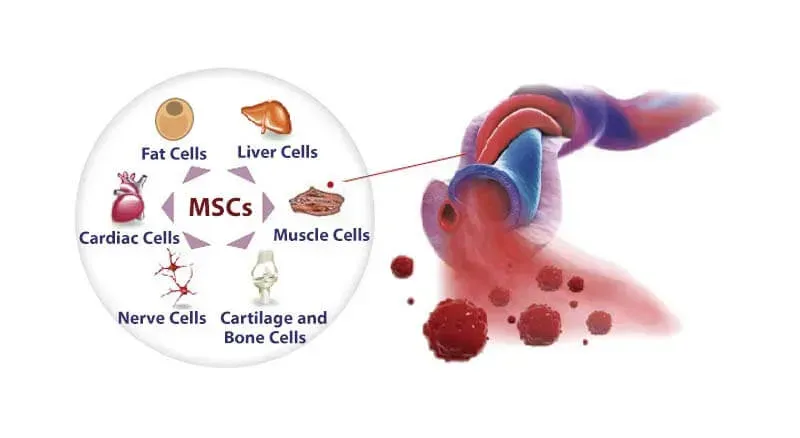Stem Cell Therapy In Anchorage, AK
A Breakthrough in Pain Management Treatment!

Minimally Invasive

No Downtime

Non-Surgical

Fast Healing

Safe & Comfortable
What Is Stem Cell Therapy?
Umbilical cord stem cell therapy (MSC) is an advanced medical treatment that uses stem cells derived from the umbilical cord of newborns. These stem cells have the unique ability to develop into various types of cells within the body, making them highly effective in promoting healing and tissue regeneration.
This therapy can be particularly beneficial for conditions like back pain, neuropathy, and knee pain. When pain or injury occurs, it's often due to damaged tissues that have difficulty healing on their own.
Stem cells target these damaged areas, reduce inflammation, and stimulate the body's natural healing processes.
For instance, in cases of back pain, stem cells can help repair the damaged tissues in the spine, leading to reduced pain and improved mobility.
If neuropathy is causing pain and discomfort, stem cells can assist in repairing and regenerating nerve tissues, providing relief from symptoms. For knee pain, particularly from arthritis or injury, stem cells can regenerate cartilage and reduce inflammation, improving knee function and overall quality of life.
The procedure is minimally invasive, involving the injection of stem cells directly into the affected area. Over time, many patients experience significant pain relief and enhanced function, allowing a return to daily activities with less discomfort.
Stem cell therapy offers a natural and effective way to heal the body and improve quality of life.

How Does Stem Cell Therapy Work?
Here's how it works:
Harvesting Stem Cells: MSCs are collected from the umbilical cord tissue, particularly from Wharton's jelly, after a healthy, full-term birth.
Preparation: The harvested umbilical cord stem cells are processed and prepared for injection, ensuring they are viable and ready to promote healing.
Targeted Delivery: The stem cells are injected directly into the area of injury or inflammation, such as joints, spinal discs, or nerves.
Anti-inflammatory Effects: MSCs release bioactive molecules that reduce inflammation in the targeted area, helping to alleviate pain and swelling.
Tissue Repair and Regeneration: These stem cells have the ability to differentiate into various cell types, such as cartilage, bone, or nerve cells, which aids in repairing and regenerating damaged tissues.
Immune Modulation: MSCs help modulate the immune system, reducing abnormal immune responses and promoting a more balanced healing environment.Here's how it works:
Harvesting Stem Cells: MSCs are collected from the umbilical cord tissue, particularly from Wharton's jelly, after a healthy, full-term birth.
Preparation: The harvested umbilical cord stem cells are processed and prepared for injection, ensuring they are viable and ready to promote healing.
Targeted Delivery: The stem cells are injected directly into the area of injury or inflammation, such as joints, spinal discs, or nerves.
Anti-inflammatory Effects: MSCs release bioactive molecules that reduce inflammation in the targeted area, helping to alleviate pain and swelling.
Tissue Repair and Regeneration: These stem cells have the ability to differentiate into various cell types, such as cartilage, bone, or nerve cells, which aids in repairing and regenerating damaged tissues.
Immune Modulation: MSCs help modulate the immune system, reducing abnormal immune responses and promoting a more balanced healing environment.
Support for Healing: MSCs create a supportive environment for the body’s own cells to repair damaged tissue by secreting growth factors and other molecules that encourage cell growth and tissue repair.
Long-term Benefits: Over time, the repaired tissues can lead to improved function, reduced pain, and enhanced mobility, contributing to a better quality of life.
Stem cell therapy is considered a promising treatment option for conditions like osteoarthritis, tendon injuries, and other degenerative diseases, as it aims to heal the root cause of pain and dysfunction rather than just managing symptoms.

What Are The Benefits Of The Stem Cell Therapy?
Stem cell therapy offers several benefits, particularly for patients dealing with chronic pain, injuries, and degenerative conditions. Here are some of the key benefits:
Non-invasive Collection: Umbilical cord stem cells are collected from healthy, full-term births, making the process non-invasive and ethical, with no harm to the mother or baby.
High Potency: Umbilical cord stem cells are young and highly potent, with a strong ability to multiply and differentiate into various cell types, enhancing their effectiveness in promoting healing.
Anti-inflammatory Properties: These stem cells release bioactive molecules that reduce inflammation, which can help alleviate pain and swelling in affected areas.
Tissue Regeneration: Umbilical cord stem cells can differentiate into various types of cells, such as cartilage, bone, and nerve cells, aiding in the repair and regeneration of damaged tissues.
Immune System Modulation: The stem cells can modulate the immune system, reducing abnormal immune responses and promoting a balanced healing environment.
Reduced Risk of Rejection: Since umbilical cord stem cells are less mature, they have a lower risk of being rejected by the recipient’s body compared to other types of stem cells.
Minimal Risk of Complications: The use of umbilical cord stem cells carries a low risk of complications or adverse reactions, making it a safe option for many patients.
Effective for Multiple Conditions: This therapy can be used to treat a wide range of conditions, including back pain, neuropathy, knee pain, arthritis, and other musculoskeletal issues.
Improved Quality of Life: By reducing pain and enhancing tissue repair, umbilical cord stem cell therapy can lead to improved mobility, function, and overall quality of life.
Quick Recovery Time: Patients often experience quicker recovery times and less downtime compared to more invasive treatments, allowing them to return to their daily activities sooner.
Stem Cell Therapy Helps Patients With:
Osteoarthritis: Helps regenerate damaged cartilage and reduce pain in joints such as the knees, hips, and shoulders.
Rheumatoid Arthritis: Can reduce inflammation and promote joint repair in patients with autoimmune-related joint damage.
Tendon Injuries: Aids in the repair of tendons affected by conditions like tendinitis or tears, including Achilles tendon injuries.
Ligament Injuries: Supports the healing of ligaments, such as ACL or MCL injuries in the knee.
Rotator Cuff Injuries: Helps repair torn or damaged tissues in the shoulder’s rotator cuff.
Back Pain and Spinal Conditions: Can alleviate pain associated with degenerative disc disease, herniated discs, and other spinal conditions.
Meniscus Tears: Promotes healing and regeneration of the meniscus in the knee, potentially avoiding surgery.
Hip Labral Tears: Aids in the repair of the labrum in the hip joint, reducing pain and improving mobility.
Plantar Fasciitis: Supports the healing of the plantar fascia, reducing pain in the heel and foot.
Bursitis: Reduces inflammation and promotes healing in bursae, the fluid-filled sacs that cushion joints.
Chronic Joint Pain: Alleviates pain in various joints, including knees, hips, shoulders, and elbows, by repairing damaged tissues.
Cartilage Damage: Helps regenerate cartilage in joints affected by injury or degenerative conditions.
Muscle Tears: Aids in the recovery of torn muscles, reducing pain and restoring function.
Bone Fractures: Accelerates the healing process in fractures, especially in cases where traditional healing is slow.
Degenerative Disc Disease: Can help regenerate spinal discs and reduce chronic back pain associated with disc degeneration.
Avascular Necrosis: Promotes blood flow and tissue regeneration in bones affected by reduced blood supply.
Chronic Inflammatory Conditions: Helps manage chronic inflammation in conditions like inflammatory bowel disease or chronic tendonitis.
Neuropathy: May reduce pain and improve nerve function in conditions like peripheral neuropathy.
Stem Cell Therapy FAQ's
How does Stem Cell therapy work?
Umbilical cord stem cell therapy works by using powerful, young stem cells collected from the umbilical cord after a healthy birth.
These cells are then injected into the area that needs healing, like a joint or a nerve. Once there, the stem cells get to work by reducing inflammation and helping to repair and regenerate damaged tissues.
The whole idea is to give your body a natural boost in its healing process, so you can experience less pain and better mobility without needing invasive surgery.
Does Stem Cell therapy work?
It’s a question many people ask, and the answer is, yes, for a lot of people, umbilical cord stem cell therapy really can make a difference.
The concept is pretty straightforward—your body already uses stem cells to repair and heal itself, and this therapy simply amplifies that natural process right where you need it most.
Many who’ve undergone the treatment report less pain and improved mobility, especially for conditions like arthritis, joint pain, and injuries.It’s not a miracle cure for everyone, but if you’re dealing with chronic pain or a stubborn injury that just won’t heal, umbilical cord stem cell therapy can be a real game-changer. And since it’s typically less invasive than surgery and uses young, potent stem cells, the risks are relatively low.
As with any treatment, results can vary depending on the condition and how your body responds. But overall, many people have seen some truly promising improvements with umbilical cord stem cell therapy.
How effective is Stem Cell therapy?
Well, it can be pretty effective, but it really depends on what you're dealing with.
For a lot of people, especially those with joint pain, arthritis, or injuries that just won't heal, stem cell therapy can make a big difference. It helps reduce pain, improves mobility, and can even speed up the healing process by regenerating damaged tissues.
That said, it's not a one-size-fits-all solution.
Some people see amazing results and feel a lot better, while others might notice more gradual improvements. The effectiveness can also depend on factors like the severity of your condition, where the stem cells are being used, and your overall health.
Overall, though, many folks find stem cell therapy to be a really effective alternative, especially if they’re trying to avoid surgery or long-term use of pain meds. It's definitely worth considering if you're looking for a way to help your body heal more naturally.
Is Stem Cell therapy safe?
It’s considered safe, especially when using stem cells from umbilical cord tissue. Because these are young, potent stem cells, the risk of rejection or a bad reaction is very low, which is a significant advantage compared to other treatments.
The procedure itself is minimally invasive, typically just involving an injection, so it’s far less intensive than undergoing major surgery. As with any medical procedure, there are some risks, such as infection or soreness at the injection site, but these are usually quite rare.
Overall, when done properly, umbilical cord stem cell therapy is considered a safe option for many people, especially when compared to more invasive treatments like surgery.
Is Stem Cell therapy painful?
The good news is, for most people, it’s not too bad.
The process involves a simple injection of the stem cells into the area that needs treatment. Since the stem cells are already prepared and ready for use, there’s no need for a harvesting procedure, which eliminates that step entirely.
The injection itself might cause some soreness, especially if it’s going into a sensitive area like a joint. However, it’s typically done with local anesthesia, so you won’t feel much during the procedure.
Afterward, you might experience some soreness or stiffness where the injection was, similar to how you’d feel after a workout or a minor injury. Most people describe it as more of a discomfort than actual pain, and it usually subsides within a few days.
Overall, it’s not as painful as you might expect, and the benefits of the therapy can far outweigh the temporary discomfort. Plus, it’s much less intense than recovering from surgery or dealing with chronic pain in the long term.
© 2024 Alaska Med Spa & Chiropractic - All Rights Reserved
*Individual results are not guaranteed and may vary from person to person. Images may contain models.
This website does not provide medical advice. The information, including but not limited to, text, graphics, images, and other material contained on this website are for informational and educational purposes only. No materials, opinions, products, and services on this site are intended to be a substitute for professional medical advice, diagnosis, or treatment. Always seek the advice of your physician or other qualified professional health care provider with any questions you may have regarding a medical condition or treatment and before undertaking a new health care regimen, and never disregard professional medical advice or delay in seeking it because of something you have read on this website.
If you have or suspect you may have a health problem or need immediate medical attention, you should consult with a healthcare provider.
We are not responsible for how the content on this website is interpreted or what reliance is placed on it. We do not accept any liability and responsibility for the results of any action taken on the basis of the information provided on this website.



